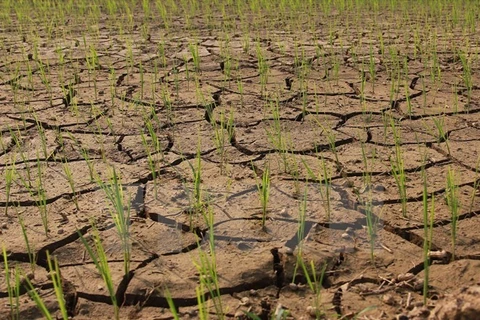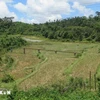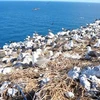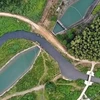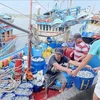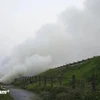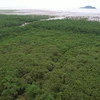 Many hectares of fields are left uncultivated due to prolonged drought and salt intrusion. (Source: VNA)
Many hectares of fields are left uncultivated due to prolonged drought and salt intrusion. (Source: VNA) Can Tho (VNA) – The Mekong Delta has been hit a double blow of prolonged drought and salt intrusion due to the impacts of El-Nino, as well as low water supplies from underground and the upper river.
According to a report by Can Tho University released in March, there are 11 irrigational reservoirs along the Mekong River. Another 77 projects are under construction through 2030. As the lowest area along the river, Vietnam’s Mekong Delta has suffered the worst damage.
Deputy Director of Mekong Delta Research Institute for Climate Change Le Anh Tuan cited the report, saying that the region has seen the water level in Mekong River continuously decrease during several recent years. The level fell by 3 m from 2000 to 2015. The underground water source in the region has also dropped at an annual rate of 40 cm.
The Ministry of Agriculture and Rural Development reported that as of mid-March, more than 200,000 households have suffered from serious water shortages. The figures are expected to rise in the coming months. Schools, hospitals and production establishments have also been affected.
Seawater intrusion has hit all 13 provinces and cities in the Mekong Delta, including Can Tho, which has never seen such effects before .
In Ben Tre province, sea water has encroached into all local fields. More than 60,000 households are using salt-contaminated water.
Salt water contamination, reaching 15 to 30 parts per thousand, has damaged rice crops and aquaculture in Ca Mau, Soc Trang, Bac Lieu and Kien Giang, killing shrimp and fish, and leaving many fields uncultivated.
Nguyen Van Hai and Huynh Van Da, who own two 800-1,000 square-metre fish ponds in Rach Ca village, Ham Tan commune, Tra Cu district, Tra Vinh province said normally they change their pond water once every one or two days. But it’s been almost 10 days since the last change because the salt levels in the Rach Ca canal reached between 12 to 20 parts per thousand. As the result, more and more of their fish are dying.
Meanwhile, the waterway traffic system has also been halted due to the closure of irrigational dams to stop salinity.
According to Nguyen Thanh Nhanh from the Department of Agriculture and Rural Development in Soc Trang province, all local culverts on canals have been closed to stop seawater from going inland.
Ho Van Quang owns a 20-tonne boat. He buys rice in Long Phu district, Soc Trang province and sells it in Vinh Long province. Quang said because of the interrupted waterway, it takes him much longer and costs him much more than before to do his daily business.
In Ca Mau, 23 salt-stop culverts have been kept closed for months. Hundreds of dams have been built along canals and rivers to stop seawater encroachment.
The waterway system in Tran Van Thoi, U Minh district has become almost paralysed.
Currently, Laos, China and Thailand are releasing water from their hydropower plant reservoirs to the lower Mekong River basin at a volume of 3,610 cubic metres per second.
The water is expected to arrive in the Mekong Delta in the first week of April.-VNA

